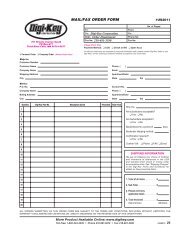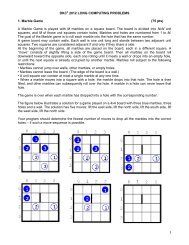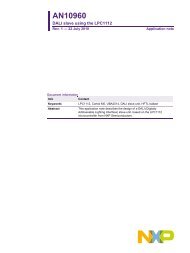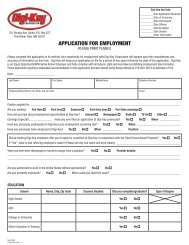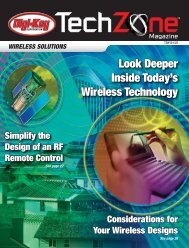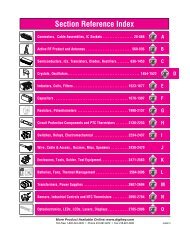Microcontroller Solutions TechZone Magazine, April 2011 - Digikey
Microcontroller Solutions TechZone Magazine, April 2011 - Digikey
Microcontroller Solutions TechZone Magazine, April 2011 - Digikey
You also want an ePaper? Increase the reach of your titles
YUMPU automatically turns print PDFs into web optimized ePapers that Google loves.
Figure 2: Schematic diagram from the<br />
Keil MCBSTM32E evaluation board.<br />
A node schematic<br />
Figure 2 shows the schematic diagram from the Keil MCBSTM32E<br />
evaluation board. IC1 is a Texas Instruments CAN transceiver that<br />
performs the conversion between the single-ended CAN controller<br />
CAN Tx and CAN Rx signals to the bidirectional differential pair of<br />
the CAN bus called CANH and CANL (High and Low). This schematic<br />
is complete.<br />
The STM32 CAN I/O is TTL, CMOS and 5 V tolerant, making it<br />
exceptionally easy to design the interface. This transceiver IC1<br />
connects to the STM32 microprocessor IC2, which contains an<br />
integral CAN controller via two pins: D (Driver input) and R (Receiver<br />
output). The corresponding nomenclature on the STM32 is CAN Rx<br />
and CAN Tx. CAN Tx connects to D. CAN Rx connects to R. Some<br />
processors have multiple CAN controllers. These are usually used<br />
in routers, gateways or to create more receiver FIFO memory for<br />
intentionally slowed down CPUs (for EMI reasons). For general use, a<br />
node normally needs only one controller. If it had at least two, it could<br />
talk to itself.<br />
RS on IC1 (slope control) is used to adjust the rise and fall times of<br />
the output edges to limit EMI from the twisted pair. Note R4 is a 120<br />
ohm termination resistor. This evaluation board is meant to be used<br />
with one other board as a small test network. If this board is used as<br />
a node, and is not at one of the ends, this resistor should be removed<br />
and external resistors used. P17 corresponds to a generally accepted<br />
standard for CAN on DB9 connectors. P17 Pin 7 is the CAN Hi bus line<br />
and pin 6 is CAN Lo. If CAN Hi and CAN Lo are reversed, the network<br />
will not operate properly. It might not work at all.<br />
There are three physical layers used in CAN: Hi-Speed, Fault Tolerant<br />
and Single Wire. Hi-Speed is the most common and is the one we will<br />
use in this article. Fault Tolerant offers more robustness as its name<br />
implies and is used more often in European autos. Single Wire is used<br />
by General Motors as a low-speed body network along with Hi-Speed<br />
main network.<br />
Hi-Speed in cars has a speed of 500 Kbps, trucks are 250 kbps.<br />
CANopen runs up to 1 Mbps. Fault Tolerant is usually 125 kbps, and<br />
GM Single Wire is normally 33.33 kbps. One Mbps in a large system is<br />
difficult to handle. 500 kbps is easier.<br />
To change from one to the other requires only the transceiver chip<br />
to be exchanged and probably changing the speed. These three<br />
layers cannot be physically connected to each other as the voltage<br />
levels are different. Use a router or gateway to join different CAN<br />
networks together. Any CAN controller will properly service all three<br />
layers of CAN.<br />
The Hi-Speed CAN physical layer is a pair of twisted wires with a<br />
120 ohm termination resistor at each end and twisted wire drops to the<br />
individual CAN nodes. A node can be directly connected to the bus.<br />
CAN Hi voltage, with respect to ground, changes between 2.5 to 4<br />
volts nominal. CAN Lo changes from 2.5 to 1 volt. Therefore, the<br />
difference between the two is either 0 volts (is logical “1”) or 3 volts<br />
(logical “0”). 0 is known as the “dominant” state and 3 volts is the<br />
“recessive” state.<br />
These two signals, CAN Hi and CAN Lo, are 180 degrees out of phase.<br />
Bus idle is when the voltage difference is zero.<br />
The CAN frame<br />
The CAN frame has many fields but can be simplified to a<br />
Programming Model as shown in Figure 3. These fields must be<br />
written by software or read from the CAN controller registers. The CAN<br />
configuration registers are not included.<br />
Figure 3: CAN Frame Programming Model.<br />
• IDE: Identifier Extension: 1-bit - specifies if the ID field is 11 or<br />
29 bits.<br />
If IDE = 0, then the ID is 11 bits.<br />
If IDE = 1, then the ID is 29 bits.<br />
• DLC: Data Length Code: 4 bits - specifies number of data bytes<br />
in frame from 0 through 8.<br />
• ID: Identifier: 11 or 29 bits as set by IDE. This part of the CAN<br />
frame sets the priority.<br />
• Data Bytes: 0 through 8 bytes. A CAN frame with only an ID field<br />
and no data bytes is valid and useful.<br />
www.digikey.ca/microcontroller<br />
49



